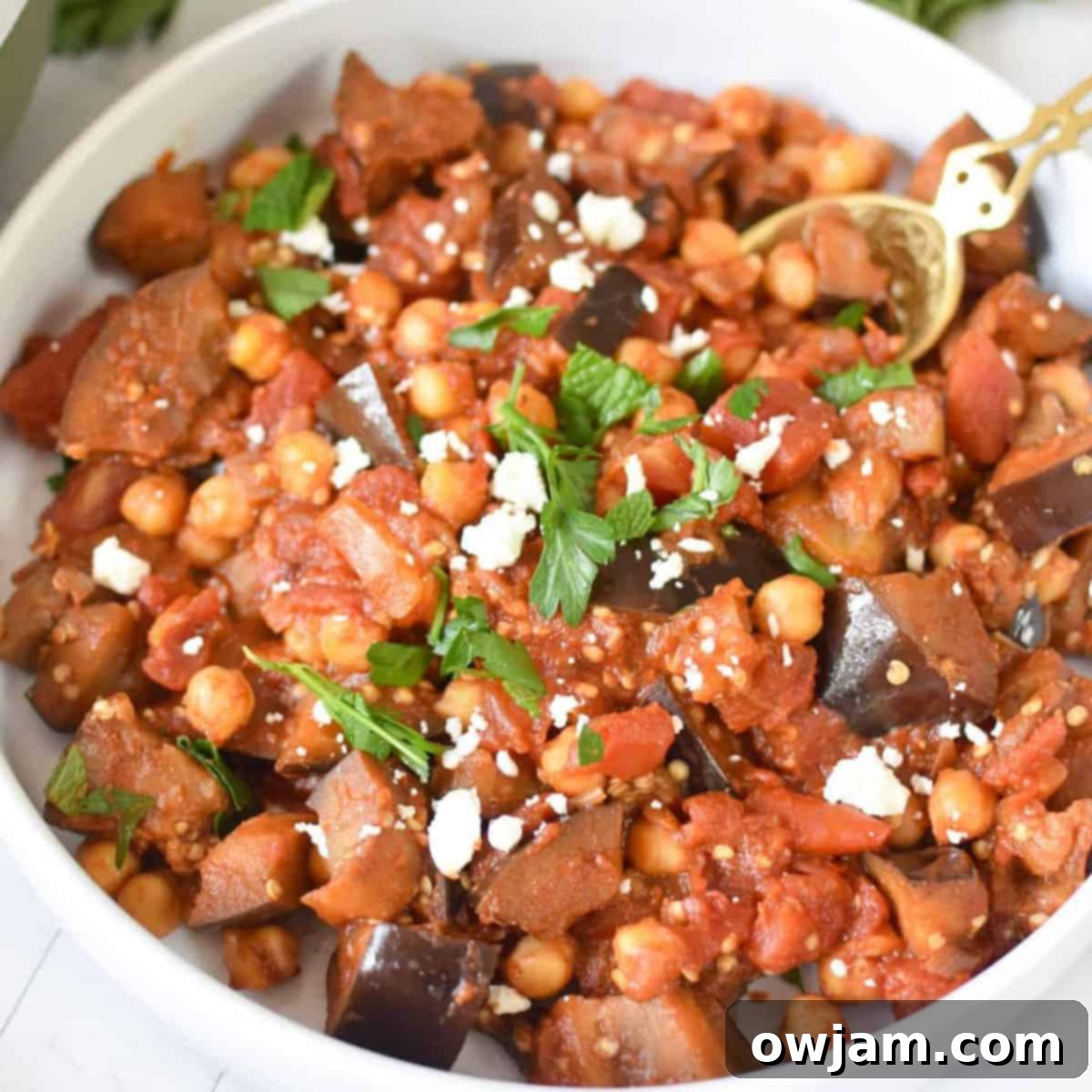Authentic Lebanese Moussaka (Maghmour): A Flavorful & Healthy Vegan Eggplant Stew
Discover the delightful world of Lebanese Moussaka, traditionally known as Maghmour. This warm and incredibly satisfying vegan dish stands out as a culinary gem, showcasing the vibrant flavors of the Middle East. At its heart, Maghmour features tender eggplant, earthy chickpeas, and sweet diced tomatoes, all simmered together with a harmonious blend of aromatic warm spices. The result is a rich, stew-like creation that is both deeply flavorful and wonderfully comforting.
To elevate this wholesome meal, we recommend a finishing touch of fresh parsley, a drizzle of creamy tahini sauce, and a sprinkle of salty feta cheese for those who aren’t strictly vegan. Serve it alongside warm pita bread to scoop up every last bit of the delicious sauce, or enjoy it over your favorite grain. This isn’t just a delicious dish; it’s also a remarkably budget-friendly meal that shines as a fantastic option for weekly meal preparation, ensuring you have healthy and flavorful leftovers ready to go!
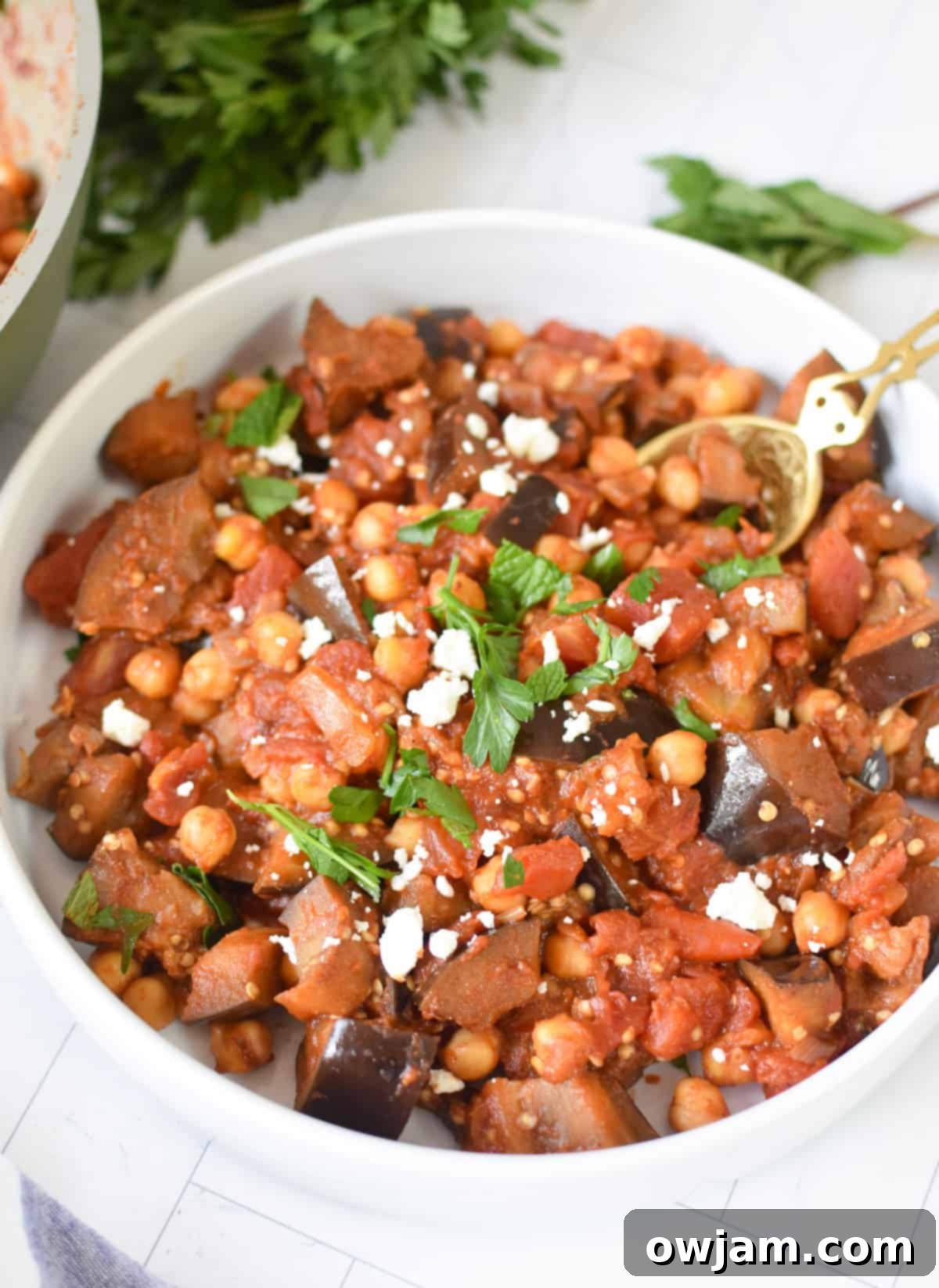
My journey into the world of Moussaka began during a memorable trip to Greece with my husband, Mike. There, we first encountered the classic Greek Moussaka—a decadent, layered casserole featuring eggplant, potatoes, a savory meat sauce, and a luscious béchamel topping. We were instantly captivated by its rich flavors and comforting texture.
Upon returning home, I was inspired to explore different interpretations of this beloved dish. My research led me to discover the Lebanese version, known as Maghmour. I was immediately intrigued by its unique, plant-based approach and knew I had to recreate it in my own kitchen. Since then, it has become a staple in our home. The primary distinction between Greek Moussaka and Lebanese Maghmour lies in their ingredients: the Lebanese rendition is entirely vegan, built around eggplant, chickpeas, and tomatoes, infused with an exquisite blend of spices, and notably omits the potatoes, meat, and béchamel sauce found in its Greek counterpart. This makes Maghmour a lighter yet equally satisfying option, bursting with Mediterranean goodness.
If you’re a fan of flavorful eggplant recipes, you’ll be delighted to explore more of our favorites. We highly recommend trying this Easy Eggplant Curry for an aromatic twist, our refreshing Mediterranean Eggplant Salad, the quick and simple Skillet Tomato and Eggplant, or our incredibly convenient Air Fryer Eggplant, perfect for crispy results with minimal oil.
Why Lebanese Moussaka (Maghmour) is a Must-Try Dish
I am a passionate advocate for simple, wholesome Middle Eastern meals that celebrate the bounty of vegetables and legumes, requiring only a handful of staple ingredients. This vegan Lebanese Moussaka, or Maghmour, perfectly embodies that philosophy. Beyond its incredible flavor, one of its most remarkable qualities is that the leftovers often taste even better than when it’s first prepared, as the spices deepen and meld overnight. Here are a few more compelling reasons why this recipe has become a cherished favorite in our household and why we believe you’ll adore it too:
- Simple, Wholesome Ingredients: The beauty of this eggplant moussaka lies in its straightforward yet powerful ingredient list. Beyond the essential aromatic spice blend, it predominantly features fresh eggplant, hearty chickpeas, and robust diced tomatoes. These three foundational ingredients, readily available and often found in your pantry, combine to create a deeply satisfying and flavor-packed meal that defies its simplicity. It’s a testament to how humble components can yield extraordinary results when prepared with care and the right seasoning.
- Remarkably Budget-Friendly: In an era where grocery costs are ever-increasing, discovering meals that are both delicious and economical is a true win. This Maghmour recipe is incredibly kind to your wallet, relying on inexpensive staples. This makes it an ideal choice for feeding a family, entertaining guests without breaking the bank, or simply enjoying a nourishing meal at a fraction of the cost of dining out. I particularly appreciate that I can easily double the batch, enjoying a fresh meal now and stashing the extra in the freezer for a quick, wholesome dinner later, further maximizing its value.
- Perfect for Meal-Prep Enthusiasts: For anyone committed to healthy eating and efficient kitchen routines, Lebanese Moussaka is a game-changer in your meal-prep rotation. It comes together in under 35 minutes of active cooking time, making it achievable even on busy weeknights. The magic truly happens, however, during the resting period. As the dish sits for a few days, the flavors intensify, allowing the eggplant, tomatoes, chickpeas, and spices to fully intermingle and develop a profound depth that only time can create. This makes it a perfect make-ahead dish that actually improves with age. It pairs exceptionally well alongside a refreshing Easy Arabic Salad or a creamy dollop of Baba Ghanoush for a complete Mediterranean feast.
This dish truly checks all the boxes: it’s naturally vegan, surprisingly simple to prepare using just a few key ingredients and a fragrant spice blend, and an absolute champion for meal prepping. The flavors mature beautifully, making the leftovers even more delightful a few days later. Give it a try – you won’t regret it!
Essential Ingredients for Your Lebanese Moussaka (Maghmour)
Crafting the perfect Lebanese Moussaka begins with selecting the right ingredients. Each component plays a vital role in building the dish’s signature deep, aromatic flavor profile and satisfying texture. You’ll find a full, detailed list of ingredients with exact measurements in the recipe card provided further down this page. For now, let’s delve into what makes each ingredient special:
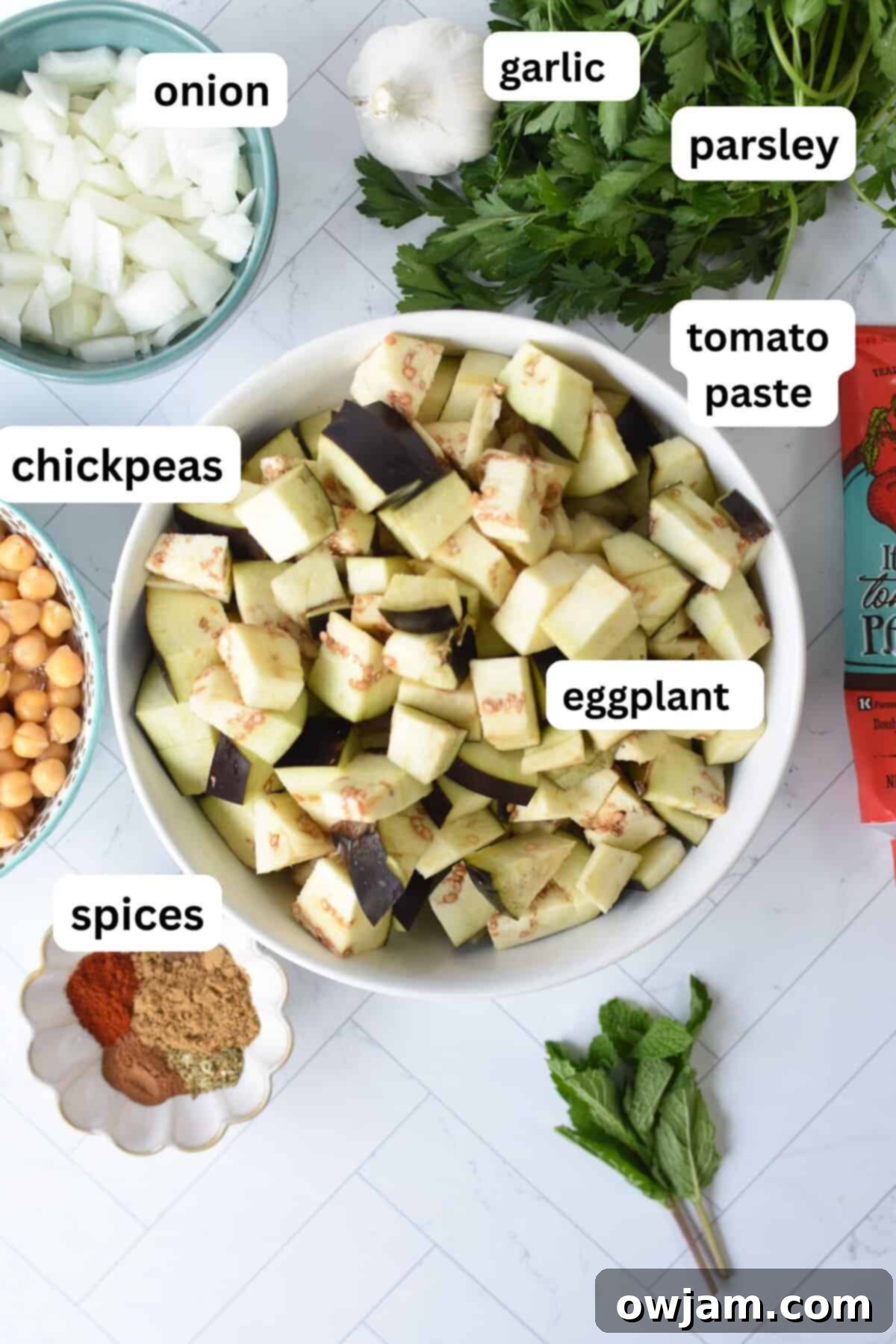
- Eggplant: The Heart of the Dish
For this recipe, aim for one large eggplant or two smaller ones. You have a few choices here: a classic globe eggplant, the slender Japanese eggplant, or an Italian eggplant all work beautifully. Whichever you choose, select firm, glossy eggplants that feel heavy for their size. It’s best to avoid extra-large or overripe eggplants, as these can sometimes be bitter and tend to become soggy during cooking, compromising the texture of your moussaka. We’ll discuss an optional salting step in the instructions that helps mitigate bitterness and excess moisture. - Aromatic Spices: The Soul of Lebanese Cuisine
The warm, intoxicating spice mixture is what truly defines Lebanese Moussaka. Our blend includes earthy cumin, vibrant paprika, subtly sweet cinnamon, fragrant allspice, pungent cloves, a hint of spicy cayenne red pepper, and refreshing dried mint. This combination creates a complex, comforting aroma and taste. Feel free to adjust the cayenne to your heat preference, or even omit it if you prefer a milder flavor. The dried mint is crucial for that authentic Mediterranean essence, adding a bright, herbaceous note that balances the rich base. - Chickpeas: The Protein-Packed Foundation
For convenience and a quick shortcut, canned chickpeas are an excellent choice. Simply drain and rinse them thoroughly before adding to the stew. If you prefer to cook from scratch, you can certainly use dried chickpeas; just remember to soak them overnight and cook them until tender before incorporating them into the recipe. Chickpeas add a wonderful creaminess, satisfying texture, and a significant boost of plant-based protein and fiber, making this dish incredibly filling. - Tomatoes: Creating the Rich Stew Base
The diced tomatoes and a generous spoonful of tomato paste are key to creating the luscious, stew-like texture and deep, rich sauce of the Maghmour. They provide the perfect acidity and sweetness, blending beautifully with the eggplant and spices. For an added layer of smoky depth, consider using fire-roasted diced tomatoes. The tomato paste concentrates the tomato flavor, thickening the sauce and ensuring a hearty, well-rounded consistency.
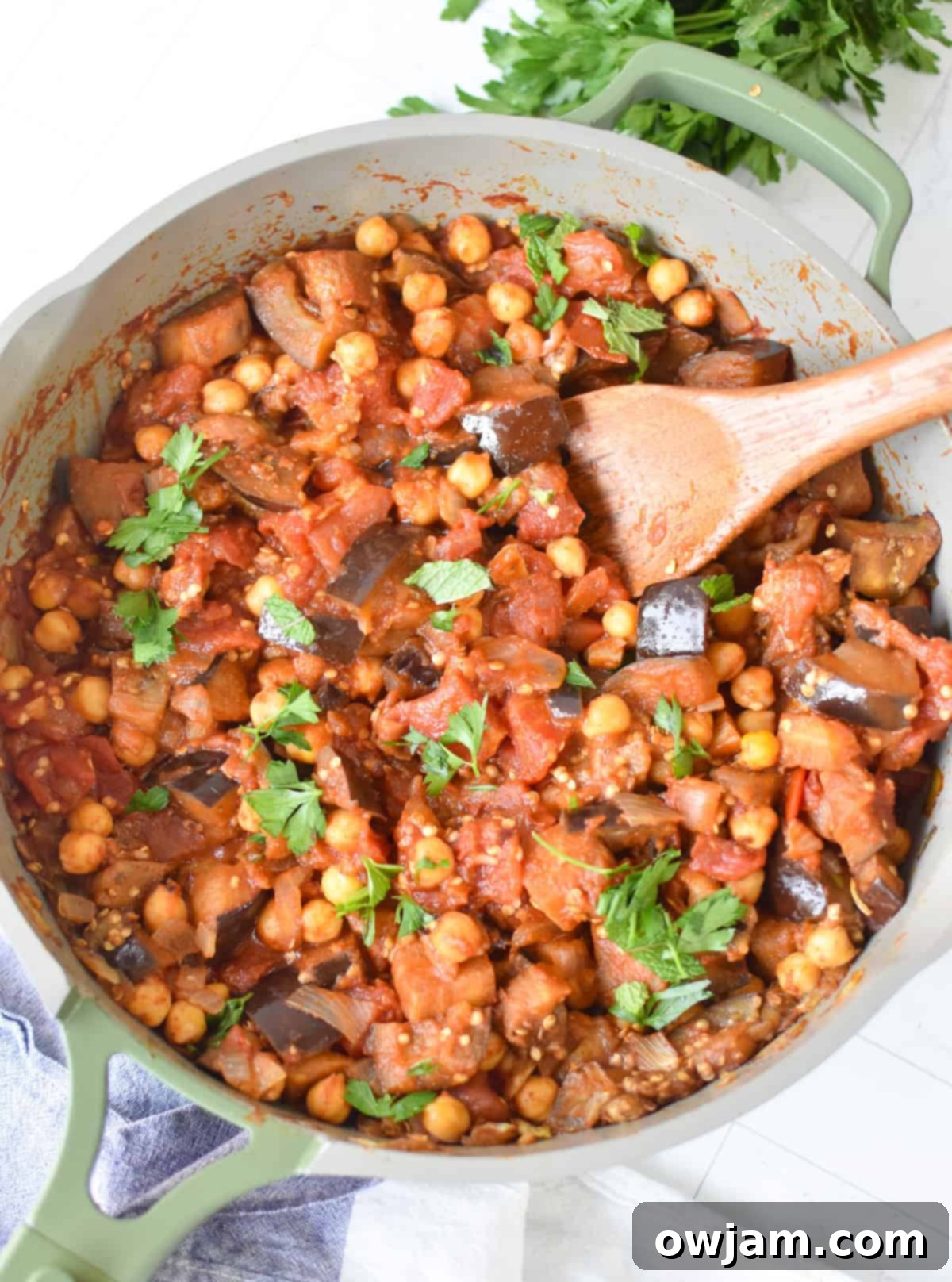
Exciting Substitutions & Creative Variations for Maghmour
While Lebanese Moussaka (Maghmour) is utterly delicious in its traditional form, it’s also wonderfully adaptable! Don’t hesitate to get creative in the kitchen by trying these exciting substitutions and variations to tailor the dish to your preferences or what you have on hand:
- Boost Your Protein: For those who prefer a non-vegan option or simply desire added animal protein, this dish welcomes it beautifully. You can easily incorporate browned ground beef, ground turkey, or ground chicken during the sautéing stage after the onions and garlic. I also love to use up leftovers by stirring in cooked Beef Shawarma, or serving the moussaka topped with flavorful Mediterranean Baked Turkey Meatballs or savory Beef Kafta Meatballs for a heartier meal. These additions transform the dish into a complete protein-packed main course.
- Ignite the Spice: If you crave a little extra heat and a bolder flavor profile, there are several ways to spice up your Maghmour. Mix in a pinch of crushed red pepper flakes with the other spices for a subtle warmth, or add a dash of your favorite hot sauce during the simmering stage. For a fresh, vibrant kick, thinly sliced fresh jalapeños can be added along with the tomatoes. These elements will add a delightful zing without overpowering the classic Lebanese flavors.
- Explore Different Beans: While chickpeas are traditional and beloved, don’t be afraid to experiment with other legumes. White beans, such as cannellini or great northern beans, make an excellent substitute, offering a creamy texture and mild flavor that blends seamlessly with the tomato base. You could also try green or brown lentils for a different texture and a nutritional boost. Remember to adjust cooking times if using dried beans that aren’t pre-cooked.
- Pack in Extra Veggies: This eggplant stew is a fantastic canvas for incorporating more vegetables. Consider adding cubed zucchini, sliced red bell pepper, or florets of cauliflower along with the eggplant. These vegetables will absorb the rich flavors of the stew beautifully and add extra nutrients, color, and texture. Spinach or kale can also be wilted into the dish during the last few minutes of simmering for an easy way to add leafy greens.
- Elevate with Creative Garnishes: Garnishes are more than just a decorative touch; they add layers of flavor and texture. Beyond fresh parsley and feta, try topping your Maghmour with tangy Quick Pickled Red Onions for a bright contrast, thinly sliced green onions for a mild oniony bite, or a handful of crispy Roasted Chickpeas for added crunch. A dollop of plain Greek yogurt or a sprinkle of toasted pine nuts can also add a luxurious touch.
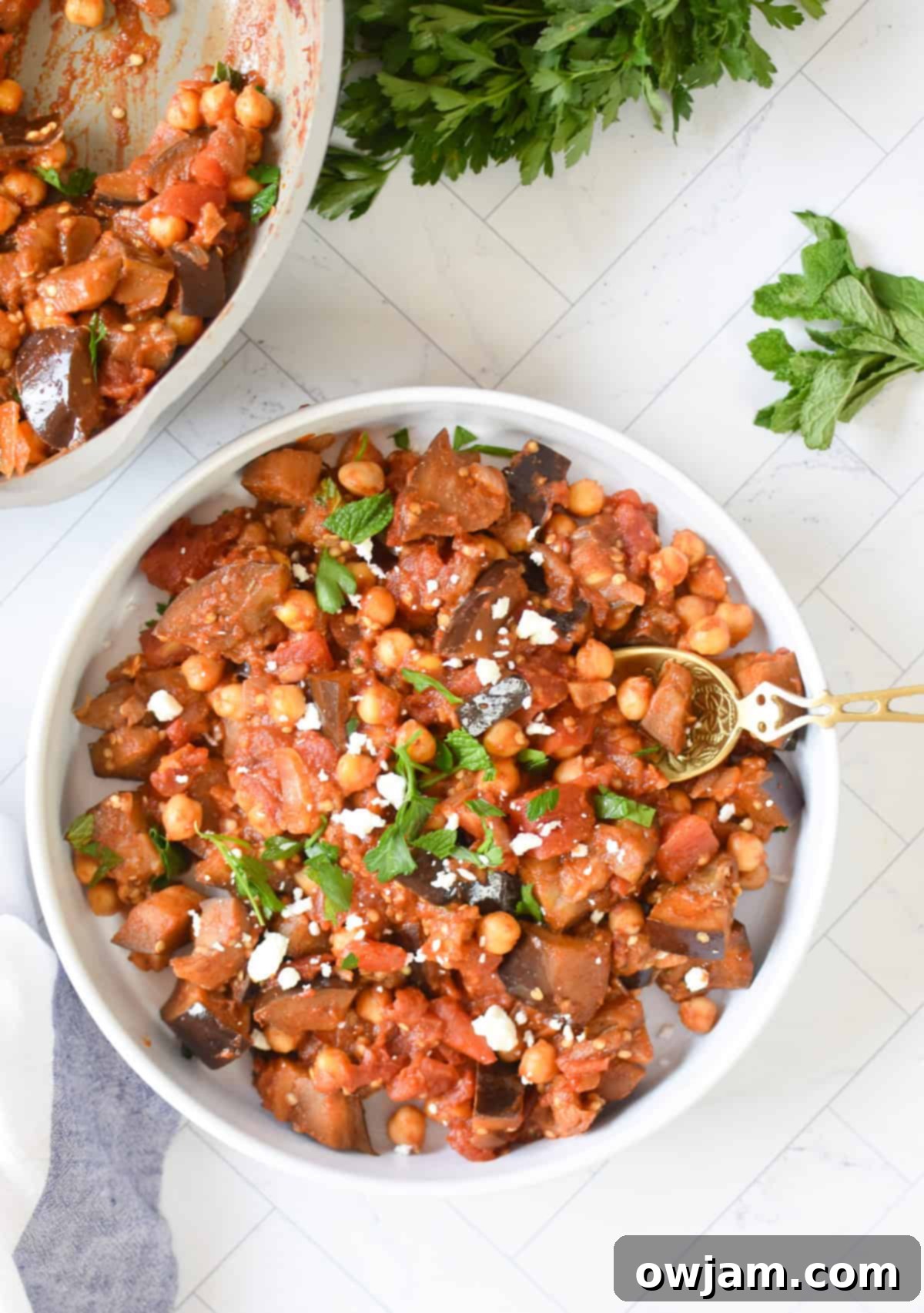
Step-by-Step Guide: Crafting Your Lebanese Moussaka
Making this authentic Lebanese Moussaka (Maghmour) is a straightforward and rewarding process. Follow these steps to create a truly delicious and comforting meal:
Optional Step: Drawing Out Bitterness from Eggplant.
To ensure your eggplant is as tender and free of any potential bitterness as possible, consider this optional but highly recommended step. After chopping your eggplant into cubes, generously sprinkle them with salt and let them sit in a colander for about 15-30 minutes. The salt will draw out excess moisture and bitterness. Before cooking, thoroughly pat the eggplant dry with paper towels. This step results in a more flavorful and less watery final dish.
Step 1: Sauté the Aromatics (Garlic & Onions).
Begin by heating the olive oil in a large, heavy-bottomed skillet or Dutch oven over medium heat. Once shimmering, add the diced onions and minced garlic. Sauté gently for approximately 5 minutes, or until the onions become translucent and fragrant. This step creates the flavorful foundation for your moussaka.
Step 2: Tenderize the Eggplant.
Add the prepared eggplant cubes to the skillet, along with a light sprinkle of salt and pepper. Sauté the eggplant for about 15-20 minutes. During this stage, the eggplant will soften significantly and begin to caramelize, developing a deeper flavor. It’s important to stir the eggplant periodically but gently; avoid stirring too much or too aggressively, as this can break down the eggplant into a purée, and we want to maintain distinct, tender pieces in our stew.
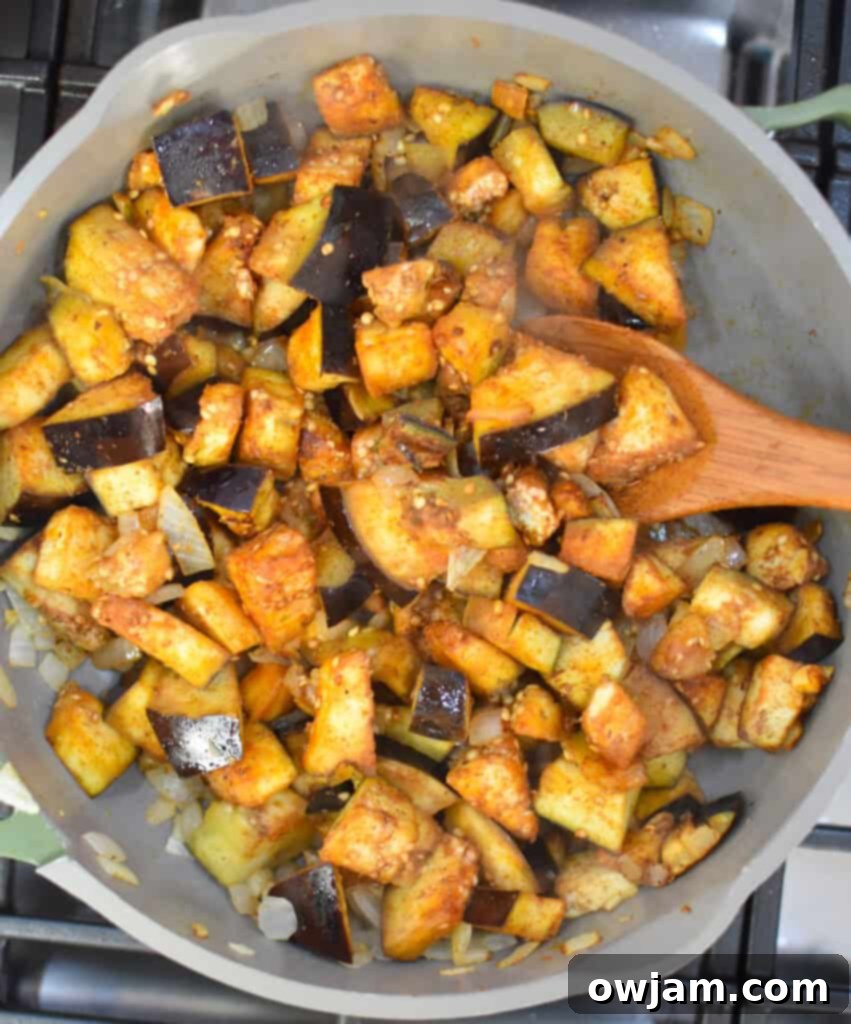
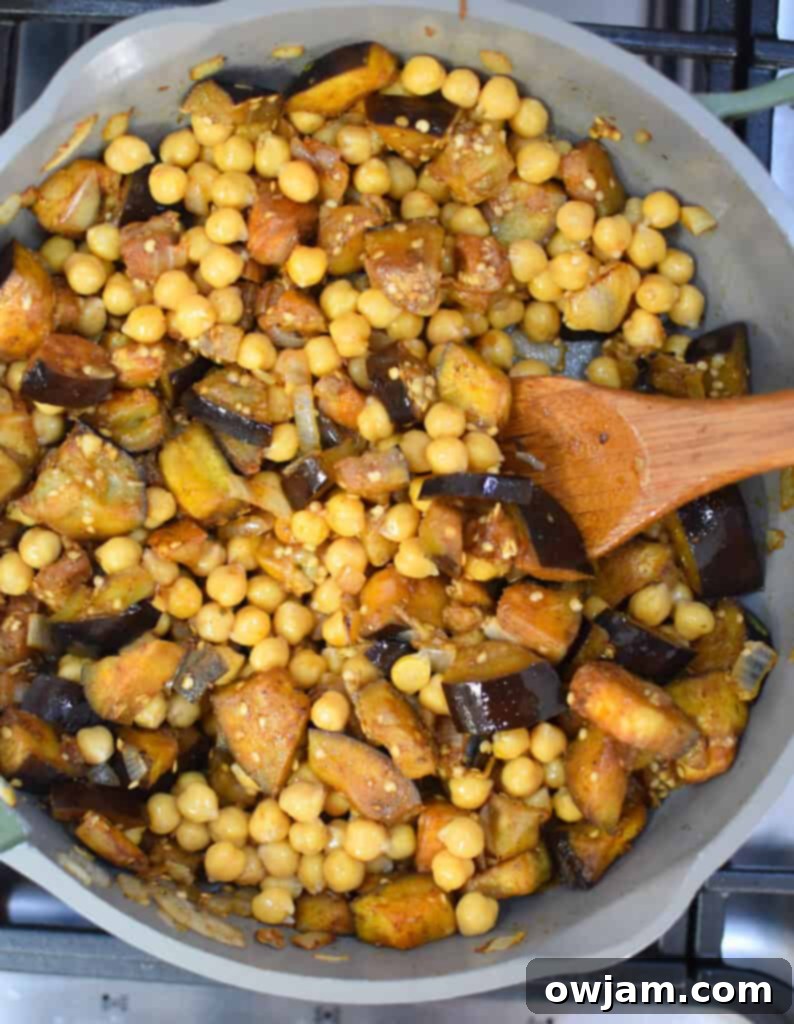
Step 3: Bloom the Spices.
Once the eggplant is tender, add the ground cumin, paprika, cinnamon, allspice, cloves, cayenne pepper (if using), and dried mint to the skillet. Stir these spices thoroughly with the eggplant mixture for about 1 minute. This brief sautéing period, often called “blooming” the spices, helps to release their essential oils and intensify their aromatic flavors, making them more potent and fragrant in the final dish.
Step 4: Combine & Simmer to Perfection.
Finally, stir in the drained and rinsed chickpeas, the can of diced tomatoes (undrained, to keep all the lovely juices), and the tomato paste. Mix all ingredients well until everything is evenly combined. Bring the mixture to a gentle simmer, then reduce the heat to low, cover the skillet, and let it cook for approximately 15-20 minutes. This simmering time is crucial, allowing all the magnificent flavors to fully meld and deepen, transforming individual ingredients into a cohesive, rich stew. Serve your Lebanese Moussaka warm, garnished with fresh parsley and, if desired, a sprinkle of feta cheese.
Recipe Tip: Achieving a Softer Eggplant Texture.
For those who prefer a more melt-in-your-mouth eggplant texture, you can partially peel your eggplant in stripes before cubing it. This leaves some skin for structural integrity and nutrients but reduces chewiness. If you dislike eggplant skin altogether, you can fully peel it. Adjust according to your personal texture preferences for the best eating experience.
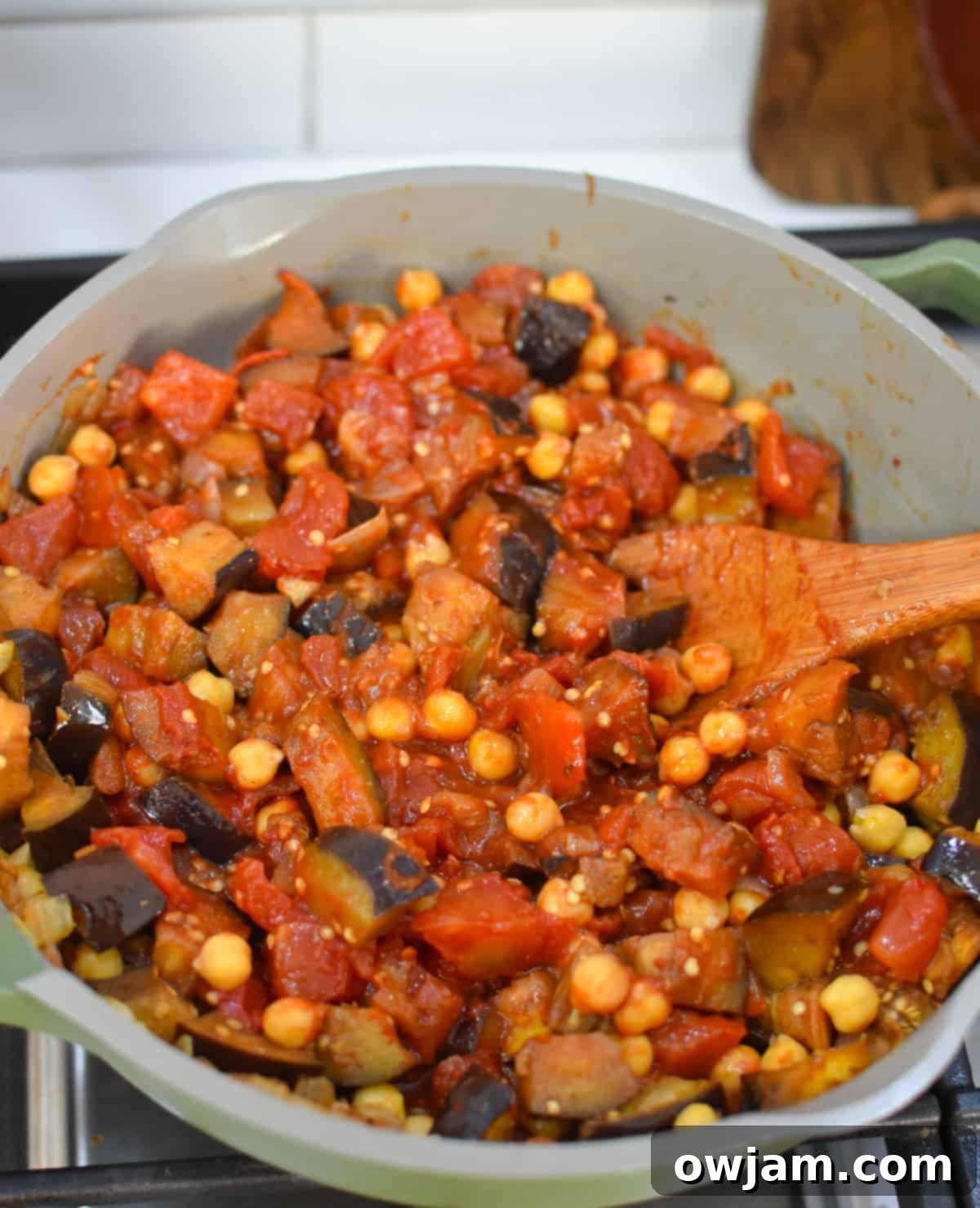
Delightful Ways to Serve Lebanese Eggplant Moussaka
Lebanese Moussaka, with its rich and aromatic profile, is incredibly versatile and pairs beautifully with a variety of Mediterranean sides, fresh salads, and creamy sauces. Here are some of my favorite ways to serve this comforting eggplant dish, transforming it into a complete and satisfying meal for any occasion:
- Refreshing Salads: A bright, crisp salad provides a wonderful counterpoint to the warmth and depth of the moussaka. Try pairing it with one of these vibrant options: the herbaceous Easy Tabbouleh Recipe for a burst of freshness, the crunchy and tangy Fattoush Salad with its toasted pita, the simple yet flavorful Malfouf Salad (Lebanese Cabbage Salad) for a light and zesty side, or our versatile Easy Lebanese Salad for an everyday accompaniment.
- Hearty Grains and Pasta: For a more substantial meal, serve your Maghmour over a bed of fluffy grains or a light pasta. It’s truly delicious spooned over a delicate Lemon Pearl Couscous, where the bright lemon notes beautifully complement the savory stew. Alternatively, a light and zesty Lemon Orzo provides a comforting base that soaks up all the flavorful juices of the moussaka. You could also serve it simply with fluffy white rice or whole wheat couscous.
- Creamy Sauces: A drizzle of a complementary sauce can add an extra layer of richness and complexity to your Lebanese Moussaka. Our classic Tahini Sauce is a perfect match, offering a nutty, creamy element that enhances the Middle Eastern flavors. For something a little different, a refreshing Creamy Dill Sauce can add a herbaceous, tangy note, or consider a Tahini Yogurt Dressing for a cool, zesty finish that beautifully balances the warm spices.
- Part of a Mezze Platter: Lebanese Moussaka is an excellent component of a vibrant mezze platter, offering a warm and hearty centerpiece. Arrange it alongside an assortment of other small plates for a communal dining experience. Some fantastic additions include savory Lebanese Meat Pie Recipe, tender Easy Stuffed Grape Leaves (or the meat-filled Meat Stuffed Grape Leaves), creamy Lebanese Hummus Recipe, and crispy Air Fryer Pita Chips for dipping.
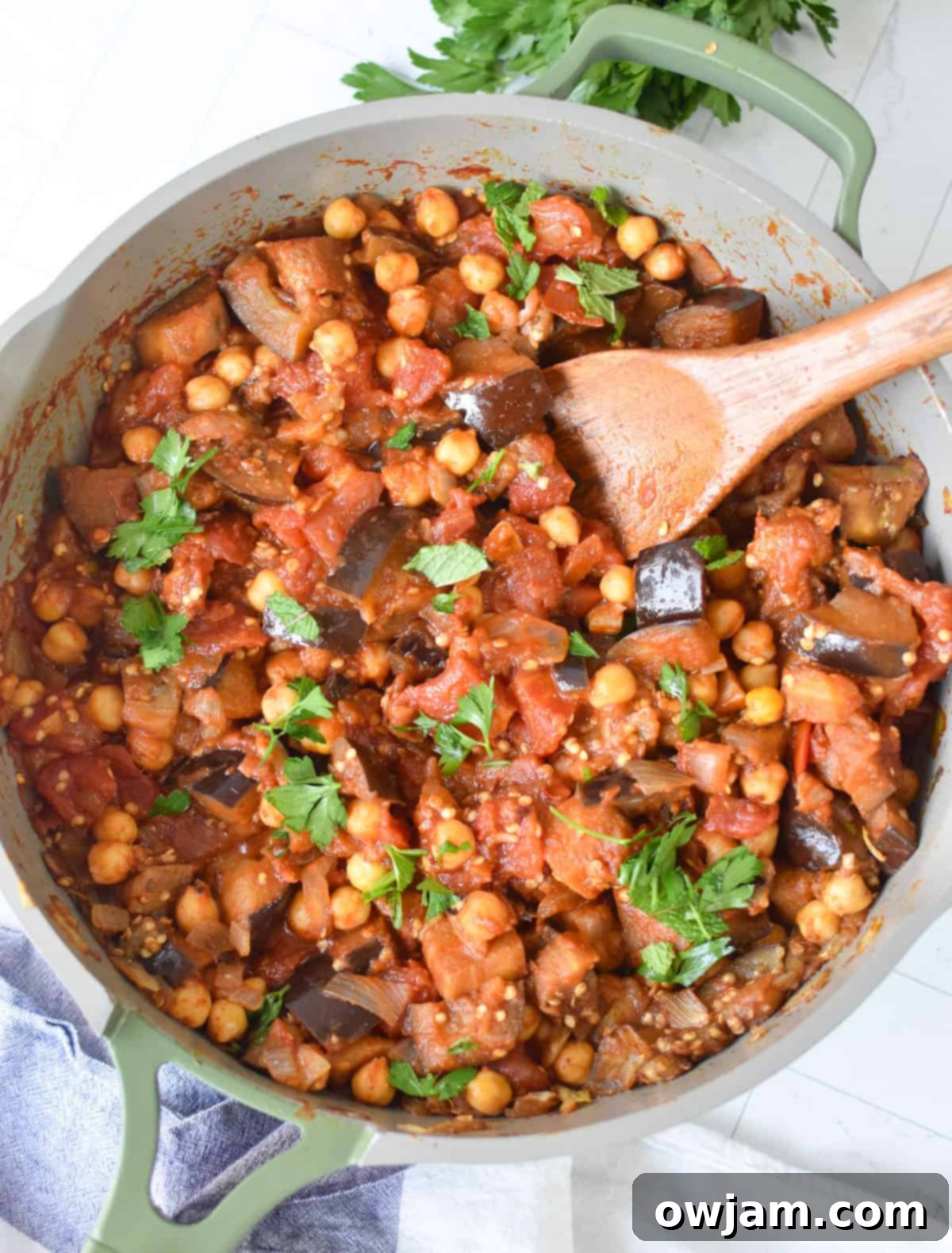
Maximizing Freshness: Storage & Freezing Tips for Maghmour
One of the many advantages of Lebanese Moussaka (Maghmour) is how wonderfully it stores, often tasting even better the next day! Whether you’re planning for leftovers or prepping meals for the week, these tips will help you keep your dish fresh and delicious:
- Refrigeration: To keep your moussaka fresh, allow it to cool completely to room temperature after cooking. Transfer it to an airtight container and store it in the refrigerator for up to 5 days. This makes it an ideal candidate for meal prepping on a Sunday, providing wholesome lunches or dinners throughout your busy week.
- Reheating: When you’re ready to enjoy your leftovers, you have several reheating options. You can gently warm it in a skillet over medium-low heat on the stovetop, ensuring it heats evenly. Alternatively, you can reheat individual portions in the microwave until warmed through. For larger batches, the oven works well: cover and bake at 325°F (160°C) until hot. If you find the moussaka has thickened considerably in the fridge, simply add a splash of water or vegetable broth while reheating to loosen it up and restore its desired consistency.
- Freezing for Long-Term Storage: Maghmour freezes exceptionally well, making it a fantastic dish to batch cook and save for future busy days. First, ensure the moussaka has cooled completely to room temperature. Then, transfer it to a freezer-safe container or heavy-duty freezer bags, leaving a little headspace if using containers. It will keep beautifully in the freezer for up to 3 months.
- Thawing & Reheating from Frozen: When you’re ready to enjoy your frozen moussaka, the best method is to transfer it from the freezer to the refrigerator and let it thaw overnight. Once thawed, reheat it using any of the methods described above (skillet, microwave, or oven) until it is thoroughly heated through and bubbling. Remember to add a bit of liquid if needed to achieve the perfect consistency.
Frequently Asked Questions About Lebanese Moussaka
You absolutely can! While this recipe calls for sautéing the eggplant in the skillet, roasting is another fantastic option. Many home cooks find that roasting the eggplant first helps to draw out moisture, concentrate its flavor, and achieve a wonderfully tender yet slightly firm texture that holds up well in the stew. It truly brings out a more robust and slightly sweeter flavor. Both methods work great, so choose the one that best suits your preference and available time!
Lebanese Moussaka is traditionally served warm, allowing the aromatic spices and rich tomato base to truly shine. The warmth enhances the comforting quality of the dish. However, it’s also quite delicious at room temperature, making it a versatile option for potlucks or picnics. While it can be eaten cold, I personally prefer serving it warm to fully appreciate its complex flavors and soothing texture.
Absolutely, and in fact, I highly recommend it! Lebanese Moussaka is one of those magical dishes that truly benefits from sitting for a day or two. The flavors have ample time to meld and deepen, resulting in an even more complex and satisfying taste. This makes it an excellent choice for meal preparation or for entertaining, as you can prepare it in advance and simply reheat it when ready to serve. It’s a fantastic make-ahead option that only gets better with time!
Yes, this traditional Lebanese Moussaka recipe is naturally gluten-free, as its core ingredients (eggplant, chickpeas, tomatoes, and spices) contain no gluten. If you need to maintain a strict gluten-free diet, simply ensure that any accompaniments you serve it with, such as pita bread, are also gluten-free. It’s a wonderfully inclusive and healthy meal option for many dietary needs.
If you love a little extra kick, it’s easy to adjust the heat level. You can increase the amount of cayenne red pepper in the spice blend. Alternatively, you can add a pinch of red pepper flakes during the sautéing of the aromatics or stir in some finely diced fresh jalapeños or a dash of your favorite hot sauce during the simmering stage. Start with a small amount and taste as you go to achieve your desired level of spice.
Explore More Delicious Eggplant Recipes
Mediterranean
Air Fryer Eggplant Fries Recipe
Mediterranean
Ratatouille Recipe
Mediterranean
Mediterranean Eggplant Chickpea Salad
Vegetarian
Ratatouille Pappardelle
Tried this recipe? Leave a star rating and comment below! Subscribe to my newsletter or follow me on Facebook, Instagram, or Pinterest for the latest.
Lebanese Moussaka
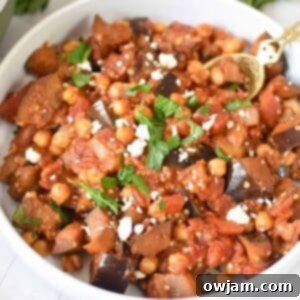
Ingredients
- 3 tablespoons olive oil
- 1 small onion, diced
- 5 cloves garlic, minced
- 1 large eggplant, cut into 2 inch cubes
- 1 teaspoon cumin
- 1 teaspoon paprika
- 1/2 teaspoon cinnamon
- 1/2 teaspoon allspice
- 1/4 teaspoon cloves
- 1/4 teaspoon cayenne red pepper, optional
- 1 tablespoon dried mint, or 3 tablespoons fresh mint
- 1 – 15.5 oz can of chickpeas or about 1 cup dried chickpeas
- 1-15 ounce can of diced tomatoes
- 3 tablespoons tomato paste
- Fresh parsley, garnish
- Feta cheese, garnish
Instructions
- Optional Step: Salt the chopped eggplant and let it sit for 15 minutes to draw out bitterness and moisture. Pat dry before adding it to the skillet.
- In a large skillet heat the olive oil over medium heat. Add the onions and garlic sauté for 5 minutes.
- Add the eggplant and a sprinkle of salt and pepper. Saute the eggplant for 15-20 minutes or until the eggplant is soft. Try not to stir the eggplant too much or too hard or it will break the eggplant down into a puree.
- Add the cumin, paprika, cinnamon, allspice, cloves, cayenne pepper and dried mint. Stir well.
- Stir in the chickpeas, diced tomatoes and tomato paste and stir well. Simmer for about 15-20 minutes to help the flavors develop. Serve warm with fresh parsley and feta cheese.
Notes
- You also can roast the eggplant first instead of cooking in the skillet. To do this preheat the oven to 400 degrees F. Coat with half the olive oil and roast in the oven until tender, about 25-30 minutes.
- Store this moussaka in an airtight container for up to 5 days. To reheat you can heat in a skillet, oven or microwave. If it is too thick you can add a bit of water or broth to loosen and thin it out.
Nutrition
Nutrition information is automatically calculated, so should only be used as an approximation.
